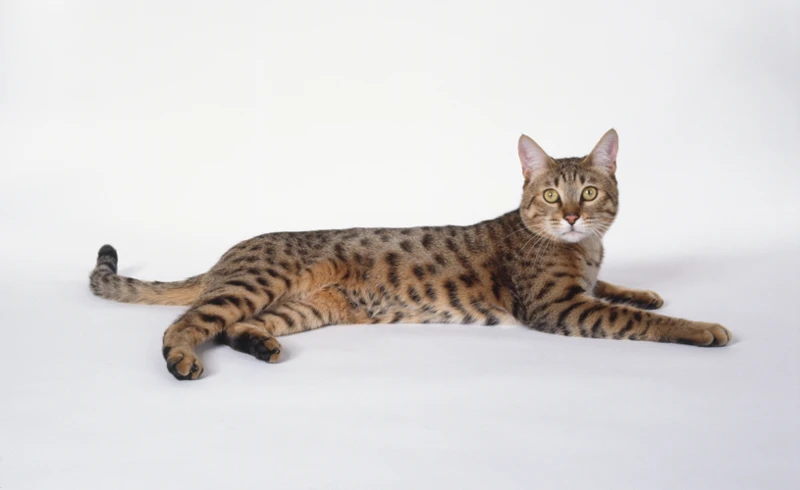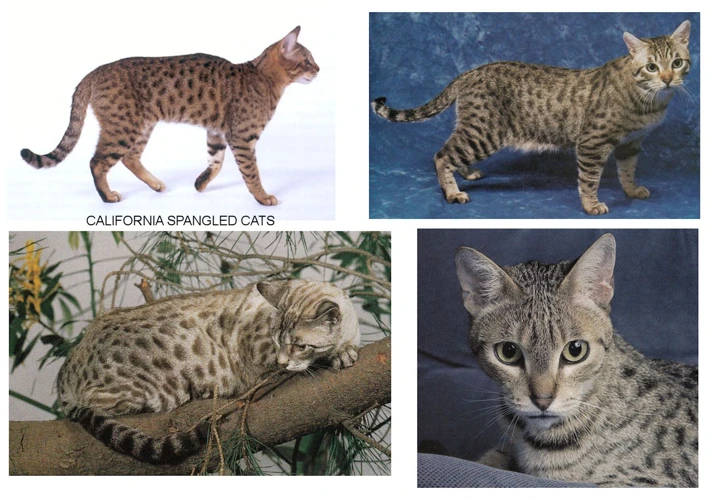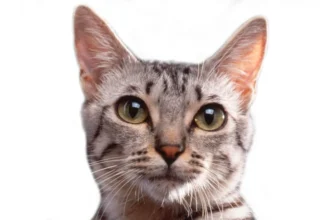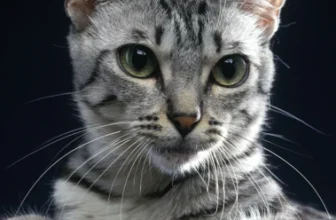Have you ever wondered why California Spangled Cats have unique physical features and personality traits? The answer lies in their genetics and inheritance patterns. Understanding these factors is crucial for cat breeders and owners, as it enables them to make informed decisions regarding breeding strategies and managing genetic disorders. In this article, we delve into the basics of genetics and inheritance in California Spangled Cats. So, grab a cup of coffee, and let’s explore the fascinating world of feline genetics together.
Genetics

As we delve into the world of California Spangled Cats, it’s important to explore the genetics behind this unique breed. Understanding the principles of genetics can help breeders make informed decisions when it comes to breeding practices, genetic testing, and managing genetic disorders. Let’s take a closer look at the basic concepts of genetics and inheritance in California Spangled Cats. For more information about California Spangled Cat pedigree, check out our article on the topic.
Chromosomes and Genes
Chromosomes are the structures in cells that carry genetic information in the form of genes. California Spangled cats, like all other living beings, have 38 chromosomes, 19 from each parent.
These chromosomes are made up of DNA, which is a long chain of nucleotides. The DNA sequence on these chromosomes contains the instructions for all the physical and genetic characteristics of the cat, from coat color to personality traits.
Each chromosome contains thousands of genes, which are segments of DNA that carry the instructions for a specific trait. For example, there are genes for coat color, eye color, and even behavior.
The genes on a chromosome can come in different versions, called alleles. Alleles are responsible for creating different variations of a trait. For example, there are multiple alleles that determine coat color in California Spangled cats.
The combination of alleles for a specific trait determines the phenotype, or physical manifestation of that trait. For example, if a California Spangled cat has two alleles for black coat color, then the phenotype will be black.
Understanding the basics of chromosomes, genes, alleles, and phenotypes is important for breeding and genetic testing. For example, to test for a genetic disorder, scientists need to identify the specific gene and allele responsible for the disorder. To breed for a specific trait, breeders need to understand which alleles will create the desired phenotype.
For more information on genetic disorders in California Spangled cats, check out our article “Identifying Genetic Disorders in California Spangled Cats.” If you’re interested in breeding California Spangled cats, we have some great tips in our article “Breeding Tips for California Spangled Cats.”
Alleles and Phenotypes
One of the most fundamental aspects of genetics is understanding alleles and phenotypes. Alleles are different forms of a gene that arise due to mutations or genetic recombination. These alleles can have different effects on the phenotype, or observable characteristics, of an organism. For example, a gene that codes for fur color may have different alleles that produce black, white, or gray fur.
The phenotype, then, is determined by the combination of alleles an individual possesses. Some alleles are dominant, meaning that they will always be expressed if present. Other alleles are recessive, meaning that they are only expressed if there are no dominant alleles present. Additionally, some traits are controlled by multiple genes, or polygenic traits, which means that multiple alleles from different genes contribute to the phenotype.
In California Spangled Cats, there are several alleles that contribute to their characteristic appearance. For example, the spotted coat pattern is controlled by the tabby allele, and the silver coat color is controlled by a dominant allele. Understanding which alleles are present in a particular cat can be important for breeding purposes.
Knowing which alleles a cat possesses can also be helpful in predicting whether they may be susceptible to certain genetic disorders. For example, the allele for polycystic kidney disease is present in some California Spangled Cats, and can be detected through genetic testing. Early detection can help owners take proactive measures to manage the condition and improve their cat’s quality of life.
Understanding alleles and phenotypes is crucial to understanding the genetic makeup of California Spangled Cats. It can help breeders make informed decisions about mating pairs and assist owners in managing their cat’s health. For more information on genetics and breeding in California Spangled Cats, see our article on California Spangled Cat Breeding Traits.
Genetic Disorders in California Spangled Cats
California Spangled Cats are known for their robust health, but like any other breed, they can be prone to certain genetic disorders. Genetic disorders occur when there is a mutation or alteration in the genetic material that is passed down from the parents to their offspring. Here are some of the common genetic disorders that can affect California Spangled Cats:
| Genetic Disorder | Description | Treatment/Management |
|---|---|---|
| Polyneuropathy | A condition where there is damage to nerves that control movement and sensation. | There is no cure for polyneuropathy, but symptoms can be managed with medication and therapy. |
| Gangliosidosis | A group of inherited disorders that affect the breakdown of certain fats and sugars in the body, leading to neurological problems. | There is currently no cure for gangliosidosis, but supportive care can help manage symptoms. |
| Hypertrophic Cardiomyopathy | A heart condition where the heart muscle becomes abnormally thick, making it harder for the heart to pump blood effectively. | Treatment options include medications to help manage symptoms and surgery in severe cases. |
| Retinal Degeneration | A disorder where there is a progressive loss of vision due to damage to the retina. | There is currently no cure for retinal degeneration, but supportive care can help manage symptoms. |
It’s important for California Spangled Cat breeders to be aware of these genetic disorders and to screen their cats for these conditions before breeding. By doing so, they can reduce the risk of passing on these disorders to future generations. California Spangled Cat owners should also be aware of the signs and symptoms of these disorders, so they can seek veterinary care as soon as possible if their cat is affected.
For more information on genetic testing for California Spangled Cats, check out our article on California Spangled Cat Genetic Testing. Additionally, it’s important to be aware of the potential impact of inbreeding on the health of this breed. Read more about this topic in our article on California Spangled Cat Inbreeding Impact.
Inheritance Patterns

One of the most fascinating aspects of genetics is the inheritance of traits from one generation to the next. Traits can be inherited in different ways, and understanding the patterns of inheritance can help breeders make informed decisions when it comes to breeding California Spangled cats. In this section, we will explore the various inheritance patterns that are important to consider when breeding these beautiful cats. So, let’s dive in and discover the complex world of genetics!
Autosomal Dominant
Autosomal dominant inheritance is a type of genetic inheritance where a single copy of the dominant gene is enough to produce a dominant phenotype. This means that if one parent has the dominant allele, there is a 50% chance that any of their offspring will inherit the gene and express the dominant trait. Some examples of autosomal dominant traits in California Spangled Cats include coat color, pattern, and body structure.
Characteristics of autosomal dominant inheritance:
- Requires only one copy of the dominant gene to express the trait.
- Does not skip generations.
- Affected individuals have at least one affected parent.
- 50% chance of passing the trait to offspring.
- Equal frequency in males and females.
It is important to note that some autosomal dominant disorders can also be lethal when inherited in a homozygous state where the individual has two copies of the dominant allele. This is known as dominant lethality. Though it is rare in California Spangled Cats, genetic testing can confirm if a cat carries the lethal allele.
Breeders carefully monitor autosomal dominant traits when planning breeding strategies. If a cat has a desirable dominant trait, breeders may choose to selectively breed the cat to pass on the trait to future generations. However, if a cat has an undesirable dominant trait such as a lethal allele, it should not be used for breeding to prevent passing on the trait.
Autosomal Recessive
Autosomal recessive inheritance is another inheritance pattern that affects California Spangled Cats. In this pattern, both copies of the gene must be mutated in order for the trait to be expressed. This inheritance pattern affects males and females equally.
An example of an autosomal recessive genetic disorder in California Spangled Cats is pyruvate kinase deficiency. California Spangled Cats with this condition have a deficiency in an enzyme called pyruvate kinase, which is required for energy production in the body. This condition can lead to anemia and other health complications.
The table below shows how autosomal recessive inheritance works:
| Genotype | Phenotype |
|---|---|
| AA | Normal |
| Aa | Carrier |
| aa | Affected |
As shown in the table, if both parents are carriers (Aa) of an autosomal recessive genetic disorder, there is a 25% chance that their offspring will be affected (aa) and a 50% chance that they will be carriers (Aa). It’s important to note that carriers do not show any symptoms of the disorder, but they can pass on the mutated gene to their offspring.
Breeders can use genetic testing to identify carriers of autosomal recessive genetic disorders and avoid breeding carrier cats together. This is important for maintaining the health of the California Spangled Cat population. However, it’s important to balance this strategy with genetic diversity to avoid the negative effects of inbreeding.
X-linked
X-linked Inheritance is a type of genetic inheritance that is determined by genes that are located on the X chromosome. In a typical female cat, every cell has two X chromosomes, but in a male cat, there is only one X chromosome. This means that males are more susceptible to X-linked disorders because they only need one copy of the disease-causing gene to express the disorder.
Table: Examples of X-linked genetic disorders in California Spangled Cats
| Disorder | Disorder Description |
|---|---|
| Hemophilia A | A disorder that impairs blood clotting |
| Red-green color blindness | A disorder that impairs the ability to distinguish colors |
| X-linked Hypohidrotic ectodermal dysplasia | A disorder that affects the development of teeth, hair, and sweat glands |
X-linked inheritance is unique because it is the only type of inheritance in which fathers cannot pass the gene to their sons. Daughters have a 50% chance of inheriting the gene from their carrier mothers and a 50% chance of inheriting a normal X chromosome. Female carriers may not exhibit symptoms of the disorder, but they can pass the affected X chromosome to their children.
Understanding the inheritance patterns of X-linked disorders is important in breeding strategies. If a male cat is diagnosed with an X-linked genetic disorder, he should not be bred. Female carriers should also be carefully evaluated before breeding to avoid passing on the affected X chromosome to their offspring.
Polygenic Traits
Polygenic traits refer to the traits that are controlled by multiple genes, unlike single-gene traits. These traits exhibit a wide range of variation in their expression, which largely depends on the collective effect of all the genes and the environment around the cats. Some of the most common polygenic traits in California Spangled Cats include coat color, eye color, and body size.
California Spangled Cats can have coat colors ranging from brown, black, white, and gray, but the underlying genetics of coat color inheritance is complex. A combination of several genes influences the color and pattern of a cat’s coat, all of which interact in unpredictable ways, making it challenging to predict the coat color of a kitten based on the parents.
Similarly, variations in eye color in California Spangled Cats are also attributed to polygenic inheritance. The color of the eyes is determined by several genes that exert additive effects resulting in a wide range of colors. The genetics behind the blue eyes of a California Spangled Cat are quite different compared to those of a green-eyed cat.
Body size is another polygenic trait that demonstrates wide variation among California Spangled Cats. Genes involved in controlling a cat’s size are believed to be located on several chromosomes, making it difficult to predict the size of offspring based on the parent’s measurements.
Understanding polygenic traits can be a challenge; hence, breeders need to be aware of the genetics of these complex traits before embarking on breeding programs. Precise selection of cats helps to improve expression of desirable traits, including better control of traits, making the breed more uniform. An example of this is selective breeding programs for coat color or eye color.
Polygenic traits in California Spangled Cats are vital for the breed’s health and productivity. Breeders should understand the heritability of these traits and use appropriate breeding strategies to improve the overall breed. Creating a detailed genetic picture of a cat’s polygenic traits and the interactions of its genes requires a deep understanding of polygenic inheritance and careful statistical analysis of data.
| Polygenic Traits | Description |
|---|---|
| Coat color | Controlled by a combination of several genes that influence the color and pattern of a cat’s coat. The genetics are complex, and predicting the color of offspring based on the parents requires careful analysis of data. |
| Eye color | Determined by several genes that interact in additive ways, resulting in a wide range of colors. The genetics behind different eye colors, including blue, green, and brown, are unique and complex. |
| Body size | Genes influencing body size are located on several chromosomes, making it challenging to predict the size of California Spangled Cats based on the parent’s measurements. Selective breeding can improve the uniformity of size and other desirable traits. |
Breeding Strategies
When it comes to breeding California Spangled cats, there are various factors breeders must consider. One of the most important decision that breeders must make is choosing the right breeding strategy. Breeding strategies are the methods used to select parent cats in order to produce kittens with desired traits. In this section, we will explore some of the most popular and effective breeding strategies for California Spangled cats. So, let’s dive into the topic and see what these strategies are all about.
Outcrossing
Outcrossing is a breeding strategy used by California Spangled cat breeders to introduce new genetic material into a breeding line. This is done by breeding a California Spangled cat with an unrelated cat from a different line or breed. The purpose of outcrossing is to improve genetic diversity and reduce the incidence of genetic disorders in the offspring.
One benefit of outcrossing is that it can increase heterozygosity, or the presence of different alleles at a particular locus on a pair of homologous chromosomes. This can lead to increased genetic variation, which can improve the overall health and vigor of the offspring.
However, outcrossing also has some potential drawbacks. For example, it can be difficult to find a suitable outcross partner that is genetically compatible with the desired traits of the California Spangled cat. Additionally, there is a risk that the offspring may inherit undesirable traits from the outcross partner, such as genetic disorders or physical traits that do not conform to the breed standard.
To mitigate these risks, breeders may use various tools and techniques to assess the genetic compatibility of potential outcross partners. These may include genetic testing, physical examination, and pedigree analysis. Breeders may choose to use selective breeding to narrow down the potential candidates for outcrossing, in order to minimize the risk of introducing negative traits.
The following table summarizes the pros and cons of outcrossing as a breeding strategy for California Spangled cats:
| Advantages | Disadvantages |
|---|---|
| Increased genetic diversity | Risk of introducing undesirable traits |
| Can improve overall health and vigor of offspring | Difficult to find suitable genetic match |
| Can lead to improved breed standard conformance | Requires careful selection and assessment of outcross partner |
Outcrossing can be a useful breeding strategy for California Spangled cats, as long as it is implemented carefully and with a thorough understanding of the genetic implications. By selecting suitable outcross partners and using genetic testing and selective breeding, breeders can help maintain healthy, genetically diverse breeding lines within the California Spangled cat population.
Inbreeding
Inbreeding is a breeding strategy in which closely related cats are bred together. While this can help to create cats that conform to the breed standard, it can also lead to genetic disorders and health problems. Inbreeding increases the frequency of homozygous alleles, which are responsible for genetic disorders. In California Spangled Cats, inbreeding can lead to issues such as heart defects, blindness, and respiratory problems.
Benefits of inbreeding
Inbreeding is known to fix certain desirable phenotypes, such as coat color and pattern. Inbreeding can produce cats with desirable physical attributes that conform to the breed standard. It can also increase the homogeneity of a breed’s genotype and phenotype.
Drawbacks of inbreeding
Inbreeding is not without its drawbacks. It can increase the frequency of deleterious alleles in the population, leading to genetic disorders and health problems. It also reduces the genetic diversity of the population, making it more vulnerable to environmental changes and diseases.
Inbreeding depression
Inbreeding depression is a phenomenon in which mating between closely related individuals leads to a deterioration in fitness traits such as litter size, immune function, and survival. Inbreeding depression occurs due to the increased homozygosity of the population.
Inbreeding coefficient
The inbreeding coefficient (F) is a measure of the degree of inbreeding within a population. It is calculated as the probability that two alleles at a particular locus in an individual are identical by descent, that is, they are both inherited from a single ancestor.
The table below shows how the inbreeding coefficient varies depending on the degree of relatedness between the parents:
| Degree of Relationship | Inbreeding Coefficient (F) |
|---|---|
| Parent-Offspring | 0.25 |
| Siblings | 0.25 |
| Half Siblings | 0.125 |
| Cousins | 0.0625 |
It is important to note that the inbreeding coefficient is not an exact measure, as it is an estimate based on available pedigree information.
Mitigating the risks of inbreeding
While inbreeding can increase the frequency of deleterious alleles in a population, there are strategies that cat breeders can use to mitigate the risks. One such strategy is to perform genetic testing on breeding cats to identify carriers of genetic disorders. Another strategy is to introduce new bloodlines into the breeding program to increase genetic diversity.
While inbreeding can have benefits in creating desirable physical traits in California Spangled Cats, it also carries significant risks. Breeders should carefully consider the potential consequences of inbreeding and take steps to mitigate the risks.
Linebreeding
Linebreeding is a breeding strategy that aims to bring out desirable traits in a particular breed while also preserving the purity of the line. It involves breeding cats that are distantly related, typically from different branches of the same family tree.
Benefits of Linebreeding:
- Linebreeding can help to fix desirable traits in a particular breed, such as the California Spangled Cat’s distinctive spots and elegant build.
- By breeding cats that are distantly related, the risk of inherited genetic disorders can be minimized.
Risks of Linebreeding:
- If not done carefully, linebreeding can lead to an increased risk of inherited genetic disorders, as well as reduced genetic diversity.
- Overly close inbreeding can lead to an increased risk of genetic defects, such as heart and respiratory problems.
Best Practices for Linebreeding:
- Linebreeding should be approached with caution and undertaken only by experienced breeders who have a thorough understanding of their cats’ genetics.
- Breeders should take care to avoid breeding cats that are too closely related, typically no closer than second cousins.
- Particular attention should be paid to inherited genetic disorders that may be present in the breed.
- Breeders should also be vigilant in monitoring the health and well-being of their cats, and be prepared to adjust their breeding strategies accordingly.
Linebreeding is a complex and potentially risky breeding strategy that requires careful consideration and expertise. While it can help to fix desirable traits in a particular breed such as the California Spangled Cat, it should only be undertaken by experienced and knowledgeable breeders who are committed to preserving the breed’s genetic health and diversity.
Conclusion
After delving into the basics of genetics and inheritance in California Spangled Cats, it’s clear that breeding these felines requires careful consideration of various factors. The intricate and fascinating world of genetics determines the traits and characteristics of these cats, and understanding this is crucial for responsible breeding practices.
By comprehending the difference between dominant and recessive traits, as well as the role of X-linked inheritance and polygenic traits, breeders can better control and predict the traits that their cats will inherit. However, genetic disorders can arise due to mutations, so it’s important for breeders to test their cats for potential genetic issues and avoid breeding cats carrying these mutations.
When it comes to breeding strategies, there are different options available. Outcrossing can bring new traits and variation to the gene pool, but it can also increase the risk of genetic disorders and dilute desirable traits. Inbreeding and linebreeding can produce more predictable traits, but it also amplifies any existing health issues or undesirable traits.
Ultimately, responsible breeding practices aim to produce healthy and happy cats with desirable traits while minimizing the risk of genetic disorders. By carefully selecting cats for breeding and regularly testing for genetic issues, breeders can contribute to the preservation and betterment of this unique and stunning breed of cats.
Frequently Asked Questions
What is genetics?
Genetics is the study of heredity and variation in organisms. It includes the study of genes, which are units of heredity that encode specific traits, and how they are passed down from one generation to the next.
How many chromosomes do California Spangled Cats have?
California Spangled Cats have a total of 38 chromosomes.
What are alleles?
Alleles refer to different versions of the same gene that determine variations in a particular trait.
Can California Spangled Cats inherit genetic disorders?
Yes, just like any other animal, California Spangled Cats can inherit genetic disorders from their parents.
What is autosomal dominant inheritance?
Autosomal dominant inheritance refers to a pattern of inheritance where the presence of a single copy of a mutated gene is enough to cause a disease or trait to be expressed.
What is autosomal recessive inheritance?
Autosomal recessive inheritance refers to a pattern of inheritance where two copies of a mutated gene must be present in order for a disease or trait to be expressed.
What is X-linked inheritance?
X-linked inheritance refers to a pattern of inheritance where the gene responsible for a particular trait or disorder is located on the X chromosome.
What is outcrossing in breeding?
Outcrossing in breeding refers to the practice of breeding individuals from different, unrelated lines in order to increase genetic diversity.
What is linebreeding in breeding?
Linebreeding in breeding refers to the practice of breeding related individuals in order to maintain a particular bloodline or set of traits.
Can polygenic traits be inherited?
Yes, polygenic traits, which are controlled by multiple genes, can be inherited from one or both parents.







